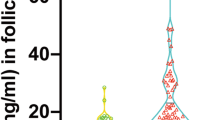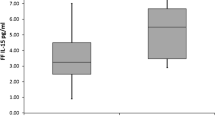Abstract
Objective
Pentraxin-3 (PTX3) is a long pentraxin that plays a key role in female fertility as a structural and essential constituent of the cumulus oophorus extracellular matrix. Despite considerable evidence supporting this role of PTX3 in mice, data in humans are scanty. The aim of the present study was (1) to evaluate follicular fluid concentrations of PTX3; (2) to test the hypothesis that levels of the molecule correlate with oocyte characteristics (corona radiata, aspect of the cumulus, nuclear maturity, and fertilization); and (3) to evaluate the possibility that peripheral concentration ofPTX3 may be of clinical help in monitoring ovarian hyperstimulation.
Methods
ELISA was used to determine PTX3 concentration. Levels of PTX3 were tested in 96 follicles.
Results
The mean ± SD and the median (interquartile range) were 17.9 ± 18.3 and 12.1 (6.5–23.6) ng/mL, respectively. Levels of the molecule did not appear to be normally distributed. At the day of ovum pick-up, levels of PTX3 were 6.3 fold higher in follicular fluid than in peripheral blood (95% Cl, 3.6—9.0). No statistically significant difference emerged Unking follicular fluid concentration of PTX3 and oocyte quality. In a series of ten women, plasma concentration of PTX3 did not vary during ovarian hyperstimulation, resulting in levels of 1.0 ± 0.5 at the 3rd day of the menstrual cycle and 1.0 ± 0.6 ng/mL at the day of oocyte retrieval
Conclusions
Results from the present study support the following conclusions: (1) elevated levels of soluble PTX3 can be found in follicular fluid; (2) follicular fluid concentration of PTX3 cannot by used as a marker of oocyte quality; and (3) plasma concentration of the molecule is not influenced by ovarian hyperstimulation.
Similar content being viewed by others
References
Amleh A, Dean J. Mouse genetics provides insight into folliculogenesis, fertilization and early embryonic development. Hum Reprod Update 2002;8:395–403.
Garlanda C, Hirsch E, Bozza S, et al. Non-redundant role of the long pentraxin PTX3 in anti-fungal innate immune response. Nature 2002;420:182–6.
Garlanda C, Bottazzi B, Bastone A, Mantovani A. Pentraxins at the crossroads between innate immunity, inflammation, matrix deposition and female fertility. Annu Rev Immunol 2005;23:337–66.
Varani S, Elvin JA, Yan C, et al. Knockout of pentraxin 3, a downstream target of growth differentiation factor-9, causes female subfertility. Mol Endocrinol 2002;16:1154–67.
Salustri A, Garlanda C, Hirsch E, et al. PTX3 plays a key role in the organization of the cumulus oophorus extracellular matrix and in in vivo fertilization. Development 2004;131:1577–86.
Lee TH, Wisniewski HG, Vilcek J. A novel secretory tumor necrosis factor-inducible protein (TSG-6) is a member of the family of hyaluronate binding proteins, closely related to the adhesion receptor CD44. J Cell Biol 1992;116:545–57.
Milner CM, Day AJ. TSG-6: A multifunctional protein associated with inflammation. J Cell Sci 2003;116:1863–73.
Zhang X, Jafari N, Barnes RB, Confino E, Milad M, Kazer RR. Studies of gene expression in human cumulus cells indicate pentraxin 3 as a possible marker for oocyte quality. Fertil Steril 2005;83 Suppl 1:1169–79.
Staessen C, Camus M, Bolle N, Devroey P, Van Steirteghem AC. The relationship between embryo quality and the occurrence of multiple pregnancies. Fertil Steril 1992;57:626–30.
Rattanachaiyanont M, Leader A, Léveilé MC. Lack of correlatgion bewteen oocyte-corona-cumuls complex morphology and nuclear maturity of oocytes collected in stimulated cycles for intracytoplasmic sperm injection. Fertil Steril 1999;71:937–40.
Ng ST, Chang TH, Wu J. Prediction of the rates of fertilization, cleavage, and pregnancy success by cumulus-coronal morphology in an in vitro fertilization program. Fertil Steril 1999;72:412–17.
Peri G, Introna M, Corradi D, et al. PTX3, A prototypical long pentraxin, is an early indicator of acute myocardial infarction in humans. Circulation. 2000;102:636–41.
Muller b, Peri G, Doni A, et al. Circulating levels of the long pentraxin PTX3 correlate with severity of infection in critically ill patients. Crit Care Med 2001;29:1404–7.
Templeton AA, Van Look P, Angell RE, Aitken RJ, Lumsden MA, Baird DT. Oocyte recovery and fertilization rates in women at various times after administration of hCG. J Reprod Fertil 1996;76:771–8.
Author information
Authors and Affiliations
Corresponding author
Additional information
Supported by the European Commission.
Rights and permissions
About this article
Cite this article
Paffoni, A., Ragni, G., Doni, A. et al. Follicular Fluid Levels of the Long Pentraxin PTX3. Reprod. Sci. 13, 226–231 (2006). https://doi.org/10.1016/j.jsgi.2005.12.008
Published:
Issue Date:
DOI: https://doi.org/10.1016/j.jsgi.2005.12.008




